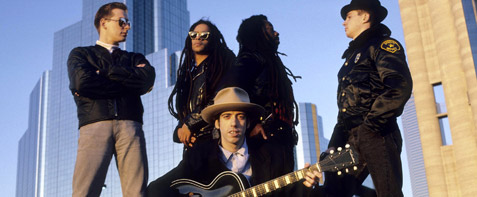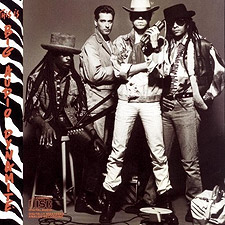
Interview Date: 04/08/2010
Run Date: 04/26/2010
Interviews Home / Music Home / Bullz-Eye Home
Big Audio Dynamite was formed by Mick Jones in the wake of his departure from the Clash in 1983. And while Big Audio Dynamite doesn't have the same name recognition or notable legacy as the Clash, they were influential in their own right by bringing the then-new art of sampling to the rock world for the first time. The original line-up of BAD would release three more albums before disbanding at the end of the decade, leaving Mick to reform the group (this time calling it Big Audio Dynamite II) with an entirely new line-up before calling it quits and hanging the Big Audio Dynamite name up for good in the late ‘90s.
In celebration of the 25th anniversary of the band’s debut album This Is Big Audio Dynamite, Columbia is re-releasing it in a new Legacy Edition, with an extra disc of b-sides, remixes and never-before-released tracks. On the eve of this new release, original keyboardist Dan Donovan spoke with Bullz-Eye about those early days with the group, what influence the band may have had on popular music, and what he's up to now.Bullz-Eye: You were the last person to join the group, how did you end up getting involved with BAD?
Dan Donovan: Well, I met Mick and everyone through a mutual friend who was working with the band at the time, doing PR and press for them. And at the time they needed a photograph for the first album's sleeve and I was a photographer at the time, and it seemed natural to hook me up with them and do the photography for the album. They happened to mention that they were looking for a keyboard player. And I said, “well I play keyboards,” which I had done for 10 years prior to working in photography, and one thing led to another, and they invited me down to play on the record.
BE: So that's why you're not on the cover of the album?
DD: Yeah, it was too late to change the picture at the point which Mick had decided that I should be in the band, but I was absolutely fine with that.
BE: You performed on all the tracks for the first album but they were already written before you got there?
DD: I played on all the tracks, and at the time I received no writing credits. However, in about 1991 Mick decided I should get a credit for “E=MC2.” So retrospectively he put me on there.
BE: That's a unique song, especially with all the sampling going on in it. Where did you get most of your samples?
DD: That particular track, pretty much all the samples on it are from Nick Roeg films, in particular “Performance.” I mean, our inspiration was films, basically. While we were doing the album we would have sort of film shows in the other room and would be constantly looking for dialogue for films that inspired us. With “E=MC2” and the Nic Roeg stuff, we rang him up and said, “Look we're basically nicking a load of stuff of you, do you mind?” And he said, “No, that's totally fine, do what you like,” so he was totally cool with that. And subsequently his son Luke Roeg directed the video for “E=MC2.”

BE: Did you contribute any samples to the album?
DD: Yes, for instance, when I first hooked up with them and started working with them in studio, I still hadn't been offered the place as a permanent member and they were doing “Medicine Show,” with all this Sergio Leone dialogue stuff. I was sitting there kind of slightly nervously, because being with Mick and stuff – he was obviously a hero of mine from the Clash days, and I said, “Well, I know a good bit of dialogue from “Treasure of Sierra Madre,”“We don't need no stinking badges.” So we dug it out, we rented it, and that became a bit of dialogue on that track.
BE: So you got most of your samples from VHS tapes?
DD: Yeah. And because I think pretty much we were the only people at that time to extensively sample from films, no one really caught on to it, in the terms of film companies or people like that. So we kind of blindly just went and did it and got away with it. Apart from getting in touch with Nic Roeg, we just did it and never had a problem with it, really.
BE: You guys were one of the first rock bands to incorporate samples, weren't you?
DD: We weren't sitting there going, “Wow, we’re doing something really new and original and no one's thought of it!” We just kind of got on with it. I mean, yeah, we just did what came naturally. But the lyrics and samples had to have some kind of meaning together. It all had to have some kind of relevance and meaning.
BE: Since it was so new, was there a steep learning curve or limitations you had to get used to?
DD: We came in at the very beginning of the technology. Without getting too nerdy about it, we actually started with an Electro Harmonix Eeplay, which didn't have a memory –you just plugged it in, and if you turned it off, you lost the samples. That was kind of the first sampler, really. So we just kind of rose with the beginning of that technology.
BE: After Megatop Phoenix, the line-up of BAD totally changed and became Big Audio Dynamite II. Do you want to share what happened there? Why did the original BAD break up?
DD: I won't go into details. I will just say that a lot of groups seem to have a shelf life of five, six, seven years before they implode. It's such an intense thing being in a group, especially like that where you're touring every year and doing albums every year. Things can get out of hand, really, and that's what happened. It happens to a lot of groups.
BE: What did you think of the later stuff?
DD: I think that BAD II did some good tracks, for sure. I think that it wasn't as interesting a mixture of personalities that the first [Big Audio Dynamite] had. Don't forget that with BAD, because I came from an artwork background and Don [Letts] came from a film and video background, we basically did everything ourselves, and I think that helped shape the look of it and give it a real kind of personal, individual feel, as opposed to expecting the record company to do things. And even from the artwork point of view that I did, it kind of had a naive quality to it because I was a photographer; I really wasn't an artwork person. I had to handwrite it all out and use my mom's 1940s typewriter to make typefaces and it had an almost amateur feel about it, but I think that made it better.
BE: I hear a lot of Big Audio Dynamite in trip-hop bands from the ‘90s like Portishead and Massive Attack. What do you think of your band's influence and legacy?
 DD: I think for sure that we definitely must have had some kind of influence over these bands in the way we combined electronic elements with guitars, and I don't think there were really too many people doing that. We we're massively influenced by hip-hop and what was going on at the time. When we did tours and had support acts, we'd always get people we liked to support us. Sometimes they weren't well received, especially in England. We had Schooly D playing with us, and it was obviously incredible but he was so new then that people hadn't caught onto it. It was almost a hangover from the end of the Clash days, when Mick was really into that direction. But I don't really know how much of an influence we had over all these people.
DD: I think for sure that we definitely must have had some kind of influence over these bands in the way we combined electronic elements with guitars, and I don't think there were really too many people doing that. We we're massively influenced by hip-hop and what was going on at the time. When we did tours and had support acts, we'd always get people we liked to support us. Sometimes they weren't well received, especially in England. We had Schooly D playing with us, and it was obviously incredible but he was so new then that people hadn't caught onto it. It was almost a hangover from the end of the Clash days, when Mick was really into that direction. But I don't really know how much of an influence we had over all these people.
The other day I looked on YouTube at some old video and footage of us playing live and stuff, and I was actually quite shocked as to how it stood the test of time. It’s not like some kind of old ‘80s sound; it’s really quite sort of different, really.
BE: I know you were in Dreadzone for a while, but what are you up to now?
DD: I was in Dreadzone in the ‘90s, most of the ‘90s on and off. I left in the middle for a while. I am currently working with a guy called Danny Briottet, who was one of the founding members of Renegade Soundwave, another ‘80s act. And we're working together on new stuff at the moment.
BE: Wow, I can't wait to hear that. Thanks for making the time to talk to me today.
DD: No problem.
You can follow us on Twitter and Facebook for content updates. Also, sign up for our email list for weekly updates and check us out on Google+ as well.












